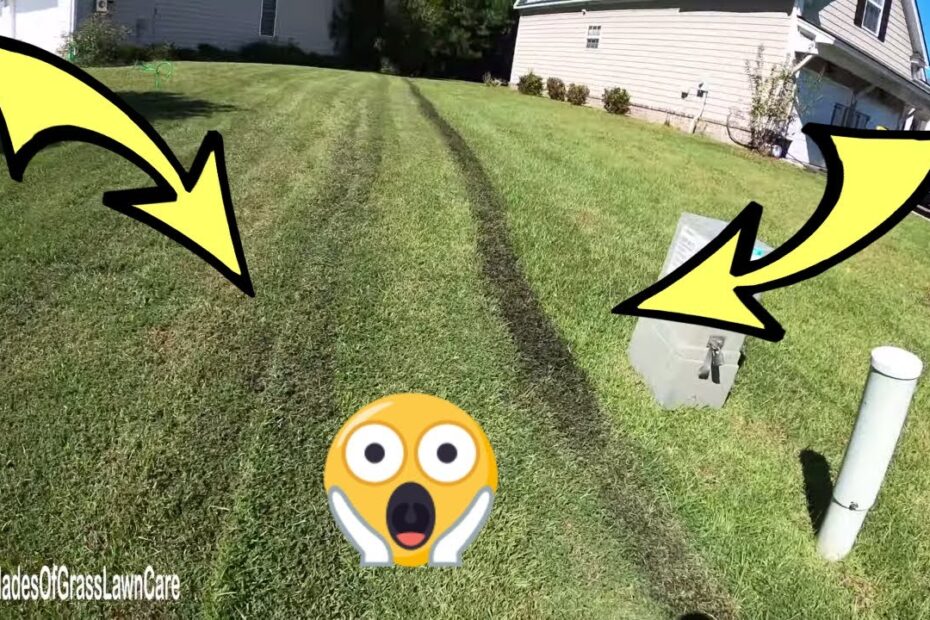
Dancing gracefully across the vibrant green canvas, tire tracks can leave the most stubborn marks on an otherwise impeccable lawn. Like an unwelcome artist wielding his brush with little regard for the masterpiece beneath, these tracks demand our attention. Yet fear not, weary homeowner, for in this article, we shall embark on a journey to rediscover the allure of a flawless turf. With a touch of creativity and a sprinkle of determination, we will unveil the secrets to mending those unsightly tire tracks, allowing your garden to flourish once again. So let us dive into the realm of tire track redemption, where we shall restore the harmony between nature and gentle human existence.

Preparing the Lawn for Repair:
Your once pristine lawn is now marred by unsightly tire tracks. Don’t despair! With a little preparation and some simple steps, you can fix those tire tracks and have your lawn looking lush and healthy in no time.
Identify the Problem Areas
The first step is to identify the specific areas affected by the tire tracks. Take a walk around your lawn and make note of the areas that require repair. These areas may have compacted soil, flattened grass, or visible tire marks. Identifying the problem areas will help you focus your repair efforts effectively.
Loosen the Soil
Once you’ve identified the problem areas, it’s time to prepare the soil for repair. Use a garden fork or aeration tool to gently loosen the compacted soil. This will improve the soil’s ability to receive water, air, and nutrients, ensuring healthier grass growth. Be careful not to destroy the grass roots while working the soil.
Repair and Revive
Next, it’s time to repair and revive the damaged grass. Start by raking any debris, such as dead grass or clumps, from the affected areas. Then, sprinkle grass seed evenly over the damaged spots, making sure to cover the area with a thin layer of topsoil or compost to protect the seeds and provide nutrients. Water the repaired areas frequently, keeping the soil moist to promote seed germination and healthy growth.
Tips for Success:
| 1. Avoid excessive watering: While keeping the repaired areas moist is essential, overwatering can drown the seeds and hinder growth. Water the lawn in the early morning or late evening to minimize evaporation. |
2. Regularly mow and fertilize: Once the new grass has grown to a recommended height, mow it to encourage denser growth. Additionally, apply a balanced fertilizer according to the manufacturer’s instructions to provide necessary nutrients for your lawn. |
3. Prevent future damage: To avoid future tire tracks, consider installing stepping stones, creating designated walkways, or redirecting traffic patterns in your lawn. These measures will help protect your lawn from further damage. |

Loading... Seconds Left for
Miniature Orchid Terrarium Gallery!

Understanding the Causes of Tire Tracks:
Tire tracks on your lawn can be a frustrating sight, but understanding the causes behind them can help you find effective solutions. One common cause of tire tracks is heavy machinery or vehicles passing over the same area repeatedly. The weight and pressure exerted by these vehicles can compact the soil, leading to visible tracks. Another cause could be improper tire pressure, where low tire pressure increases the chance of leaving tracks as the tires sink into the soil.
To fix tire tracks in your lawn, here are some handy tips and features that can help restore your lawn’s pristine look:
- Reseed the affected area: Purchase high-quality grass seeds and spread them evenly across the tire tracks. Make sure to water the area adequately to promote seed germination.
- Aerating: Utilize an aerator to create small holes in the compacted soil, allowing water, air, and nutrients to reach the grass roots.
- Top-dressing: Apply a thin layer of topsoil or compost over the tire tracks. This helps to level the area and provides the necessary nutrients for healthier grass growth.
<div class="column">
<ul>
<li><strong>Proper tire inflation:</strong> Regularly check and maintain the correct air pressure in your vehicle's tires. This reduces the chances of leaving deep imprints on the lawn.</li>
<li><strong>Path redirection:</strong> If possible, consider <a href="https://up-gardening.com/how-to-move-soil-fast/" title="How to Move Soil Fast">creating designated pathways</a> or installing walkways to shift foot and vehicle traffic away from sensitive areas of your lawn.</li>
<li><strong>Grass alternatives:</strong> In high-traffic areas, consider replacing grass with more durable alternatives like gravel paths or stepping stones to prevent tire tracks altogether.</li>
</ul>
</div>
By applying these simple tips and using these features, you can address the causes of tire tracks in your lawn and restore it to its former glory. Remember, prevention is always better than fixing, so take proactive measures to avoid future tire tracks by implementing appropriate strategies. With a little care and attention, your lawn will be back to its lush and pristine state in no time!

Maintaining a pristine and lush lawn is a task that many homeowners take pride in. However, the occasional tire tracks from vehicles or machinery can leave unsightly marks that disrupt the overall aesthetics of your yard. Luckily, with a little patience and some simple steps, you can easily fix those tire tracks and restore your lawn’s flawless beauty.
To begin with, gather the necessary tools for this job. You’ll need a sturdy garden rake, some topsoil or compost, grass seed, a garden hose with a spray nozzle, and a lawn roller if available. With these essential items in hand, follow these steps to repair those tire tracks and have your lawn looking flawless in no time.
-
Assess the damage: Before diving into the repair process, carefully examine the tire tracks and determine their depth and extent. This will help you gauge the amount of soil and grass seed required for the job, ensuring a seamless restoration.
-
Loosen the soil: Grab your garden rake and gently loosen the compacted soil within the tire tracks. Take care not to damage the surrounding healthy grass, as it will aid in the regrowth process. Lightly rake the soil to remove any debris, creating a smooth and even surface within the damaged area.

Preventing Tire Tracks in the Future:
Tire tracks on your pristine lawn can be unsightly and frustrating. While it’s best to prevent them from happening in the first place, sometimes accidents or unavoidable situations occur. Here are some tips and tricks to fix tire tracks in your lawn and prevent them in the future:
3>Tips for Fixing Tire Tracks:
- Identify the extent of the damage: Assess the depth and width of the tire tracks to determine the best approach for repair.
- Fill in the tracks: Use a garden shovel to gently level the affected area by pushing the soil back into place. Ensure it is evenly distributed and firmly packed.
- Water and compact: Lightly water the repaired area and gently compact the soil with the back of a rake or by walking over it. This will help to blend the repaired section with the surrounding turf.
To avoid the frustration of dealing with tire tracks on your lawn, consider incorporating the following tips into your lawn maintenance routine:
| Feature/Tips |
Description |
| Pathway installation |
Create designated pathways or walkways to guide foot traffic away from vulnerable areas of your lawn. |
| Proper tire inflation |
Ensure your vehicles have adequately inflated tires to spread the weight and minimize potential damage when driving on your lawn. |
| Regular aeration |
Aerate your lawn at least once a year to improve soil compaction and drainage, reducing the chances of tire tracks. |
Frequently Asked Questions
Q: Help! My lawn has ugly tire tracks. How can I fix them?
A: Fear not, weary lawn owner! We have just the answers you seek to obliterate those pesky tire tracks and restore your lawn to its former glory.
Q: WhatR
17;s the first step in repairing tire tracks on a lawn?
A: While many may assume rolling out the heavy machinery is necessary, fear not, for the simplest solution lies right beneath your feet. Begin by gently raking the affected area, removing any loose debris and levelling the ground.
Q: What magical tools can I employ to fix those unsightly tire tracks?
A: Prepare yourself for the most mystical of remedies! Grasp your trusty garden hose and water the barren tracks to encourage grass regrowth. Then, sprinkle fresh grass seed over the area, as if sowing seeds of hope. Lastly, cover the seeded area with a thin layer of compost or straw to protect and feed Mother Nature’s miracle.
Remember, dear reader, patience is key as you nurture your newly sown lawn. Soon enough, those tire tracks will become a distant memory, lost amidst the green tapestry of your revitalized haven. As we roll towards the end of this article, we hope we have been able to steer you in the right direction when it comes to fixing those pesky tire tracks in your beautiful lawn. Remember, caring for your outdoor sanctuary is an art form that requires a delicate touch and a few simple tricks up your sleeve.
Embrace the
power of prevention, for it truly is the best medicine. Strategically place stepping stones or create designated pathways to divert foot and wheel traffic away from tender grass. Taking this proactive approach will save you from any future wheel-induced woes.
However, we understand that accidents happen and even the most carefully planned landscapes can occasionally fall victim to unsightly blemishes. In such cases, the key is to act swiftly and accurately. Grab your trusty tools and embark on a mission to restore your lawn’s natural allure, one gentle touch at a time.
Remember, patience is a virtue. Nature’s resiliency will charm you, and over time, those tire tracks will fade away into distant memories. As you diligently care for your green oasis, you will witness the transformation unfold before your eyes – a testament to your dedication and unwavering commitment to nurturing the beauty of your surroundings.
So go forth
, fellow lawn enthusiast, armed with this newfound knowledge. Embrace the challenges and embrace the rewards. And always remember, with a little bit of love and a touch of creativity, you can fix those tire tracks and return your lawn to its former glory. Happy tending!
="abh_tab_content">
Hello! I'm Jessica Owen, an avid gardener and proud contributor to Up-Gardening.com. Gardening is my passion, and I'm delighted to share my green-thumb experiences with you. From planting tips to nurturing blooms, I'm here to help you cultivate your own slice of paradise. Let's grow together in the garden!
Latest posts by Jessica Owen
(see all)v>
<
!-- CONTENT END 1 -->






